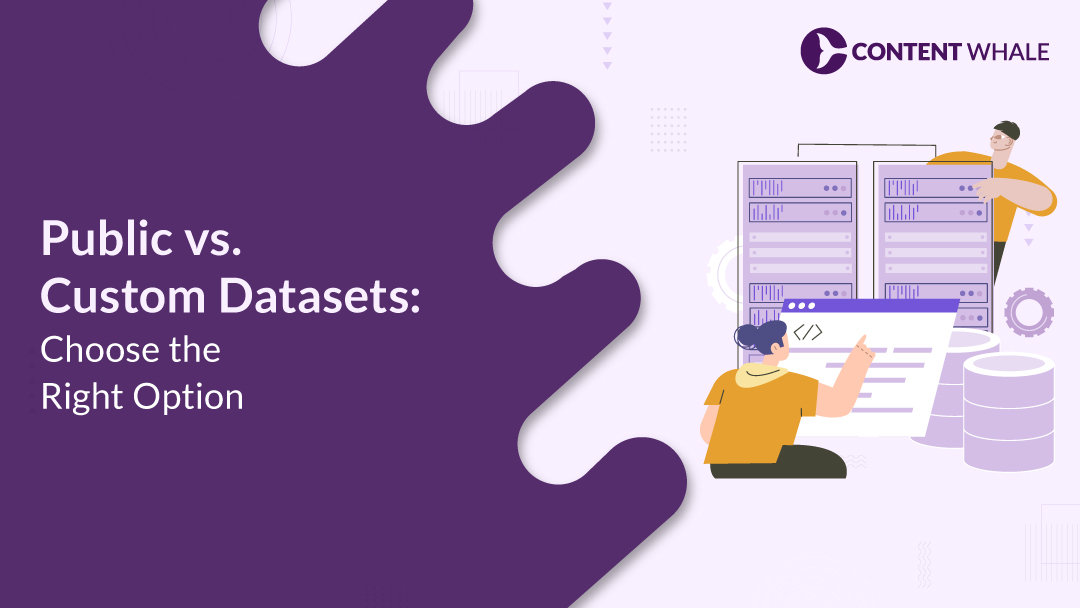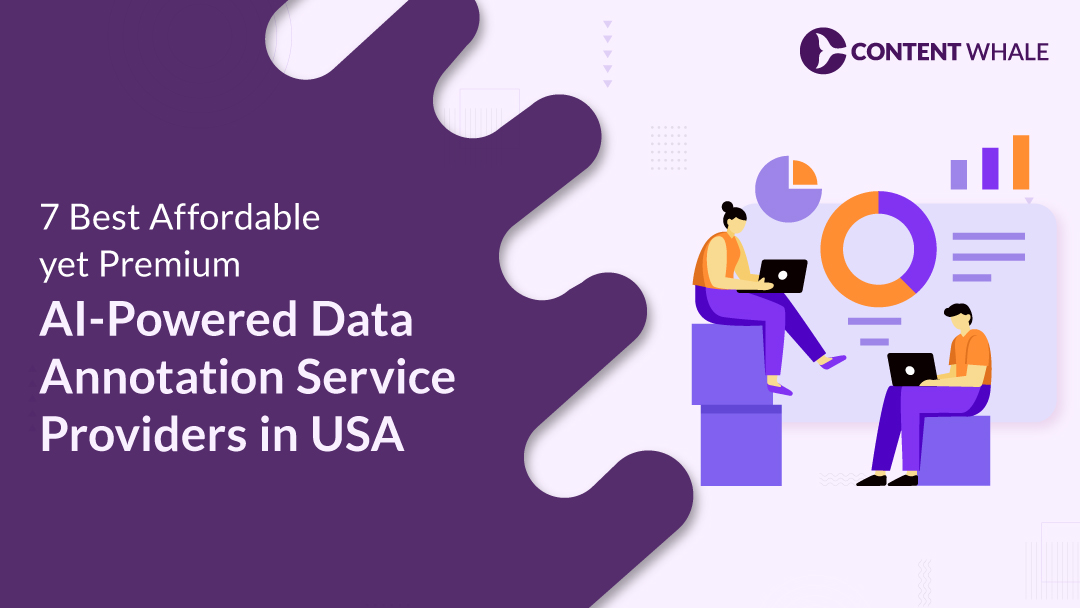If you’re serious about building a successful AI project, you need the right data—period. But here’s the kicker: your project’s success depends on choosing between public vs custom datasets for AI.
Public datasets are easy to access and often free, but they’re not always the most accurate. On the flip side, custom datasets for AI give you precision, but they’ll cost you more time and money.
In this blog, I’ll show you exactly how to weigh your options, so you can make the best choice for your AI model and get results faster.
1. Understanding Public Datasets for AI Projects
Public datasets are an attractive option for many AI projects, especially when you’re on a tight budget or need a quick start. These datasets are openly available and can be accessed via public dataset platforms like Kaggle, UCI Machine Learning Repository, or Google Dataset Search. Here’s why public datasets can work for you:
a) Advantages of Public Datasets
- Accessibility: Public datasets are easy to find, often free, and require minimal effort to integrate into your project. This makes them a go-to option for beginners or teams looking to get things moving fast.
- Large Volumes of Data: Many public datasets for AI projects offer massive amounts of information, such as machine learning datasets like ImageNet or COCO, which are widely used in training AI models.
- Community Support: Because these datasets are so widely used, they often come with extensive documentation, examples, and community-driven resources to help you get started quickly.
b) Challenges of Public Datasets
However, public datasets aren’t without their limitations:
- Lack of Specificity: Public datasets are typically general-purpose, meaning they may not align with your specific AI project needs. This can lead to lower data quality for AI models that require niche or specialized information.
- Dataset Bias: Since public datasets are often created for broad use, they may contain dataset bias in AI, affecting the performance of your model.
- AI Dataset Limitations: Public datasets don’t give you control over the AI data collection process, which can result in incomplete or irrelevant data for your project.
2. Exploring Custom Datasets for AI Projects
When your project demands precision, custom datasets for AI can be the game-changer. These datasets are created specifically for your use case, ensuring you have exactly the data you need for training your AI models. Here’s a breakdown of what makes custom datasets stand out.
a) Advantages of Custom Datasets
- Tailored to Your Needs: One of the biggest benefits of custom datasets for AI is that they are built specifically for your project. This means you get highly relevant and accurate data that aligns perfectly with your model’s requirements. No more sorting through irrelevant information like you might with public datasets.
- Higher Accuracy: With custom AI training data, you control the entire AI data collection and data sourcing for AI process. This results in fewer errors, better data labeling, and ultimately, higher-quality AI models.
- Competitive Edge: Having exclusive access to a custom dataset gives you an edge over competitors who might be using the same public datasets. Your data will be unique, which can make a significant difference in specialized AI projects.
b) Challenges of Custom Datasets
- High Cost: Creating a custom dataset isn’t cheap. You need to invest in data collection, annotated data for AI, and quality assurance, which can quickly add up.
- Time-Consuming: Collecting and preparing data for custom datasets is a lengthy process. You need the right tools, team, and strategy to ensure the data meets your AI model’s standards.
- Scalability Issues: As your project grows, scaling custom datasets can be more complex than using pre-built open data for AI or synthetic datasets.
3. Key Factors to Consider When Choosing a Dataset
Selecting the right dataset is a critical decision that can make or break your AI project. To make an informed choice between public datasets for AI projects and custom datasets for AI, consider the following key factors:
a) Relevance to Project Goals
Your dataset must align with your project’s objectives. If you’re building a specialized AI model, like one for a specific medical application, relying on public datasets could leave gaps in your training data. A custom dataset allows for precise AI data collection, ensuring it’s relevant and directly tied to your project’s goals.
b) Data Volume and Quality
While public datasets typically offer large amounts of data, they may compromise on data quality for AI. For projects that demand high precision, custom datasets give you control over quality through meticulous AI data sourcing and annotated data for AI. On the other hand, if your project can tolerate some noise, public datasets may offer the volume you need at a lower cost.
c) Budget Constraints
Cost is often a deciding factor. Public datasets are generally free or available at a low cost via public dataset platforms, making them attractive for startups or projects with limited budgets. However, custom datasets involve significant financial investment, covering data collection, labeling, and quality assurance.
d) Time and Resources for Data Preparation
Using custom datasets requires more time for gathering and preparing data, as well as handling potential AI dataset limitations. You’ll need to budget for both time and resources. In contrast, public datasets allow you to kick off your project faster, though you may need to spend time cleaning and optimizing the data for your use case.
| # | Factor | Public Datasets | Custom Datasets |
| 1 | Relevance to Project Goals | May not fully align with specific project requirements | Highly relevant, as it’s tailored to meet specific project needs |
| 2 | Data Volume | Large volumes of data readily available | Volume depends on the time and resources invested in data sourcing for AI |
| 3 | Data Quality | Can vary, may require cleaning and preprocessing | High quality, as the data is collected and labeled with your project in mind |
| 4 | Cost | Free or low-cost via public dataset platforms | High cost due to custom AI data collection and labeling |
| 5 | Time and Resources | Low time investment, data is pre-existing | Requires more time and resources for collection and validation |
| 6 | Control Over Data | Limited control over data structure and content | Full control over AI data collection, structure, and annotated data for AI |
| 7 | Bias and Fairness | More likely to have dataset bias in AI | Lower risk of bias, as the dataset is designed specifically to avoid it |
| 8 | Scalability | Easily scalable, with extensive machine learning datasets available | Scalability can be complex and expensive, depending on project needs |
4. Public vs. Custom Datasets: A Side-by-Side Comparison
Choosing between public vs custom datasets for AI depends on your project’s specific needs. Here’s a side-by-side comparison to help you understand when each option makes sense.
a) Cost
- Public Datasets: Typically free or available at a low cost. Platforms like Kaggle and UCI Repository offer a wide range of machine learning datasets without any significant financial investment. This makes them appealing for smaller projects or early-stage testing.
- Custom Datasets: Expect higher costs with custom datasets for AI. You’ll need to invest in data collection, labeling, and quality control, especially if you’re working with custom AI training data that requires specialized data sourcing for AI.
b) Accuracy
- Public Datasets: These datasets are general and may not always meet your accuracy standards, especially for niche projects. They often contain incomplete or irrelevant data that can affect the data quality for AI.
- Custom Datasets: Because they are created specifically for your project, custom datasets offer higher precision. With annotated data for AI, you can ensure that every data point serves your model’s requirements.
c) Scalability
- Public Datasets: Easily scalable. You can quickly integrate them into any project and expand as needed without much hassle. This is one of the biggest benefits of public datasets.
- Custom Datasets: Scaling custom datasets can be a challenge. Expanding the dataset requires additional resources, and the process is time-consuming, especially if you’re sourcing or labeling new data.
d) Control Over Data
- Public Datasets: You have limited control over data content. What you see is what you get, making it harder to remove dataset bias in AI or improve specificity.
- Custom Datasets: Complete control over AI data collection means you can avoid AI dataset limitations, ensuring the dataset is exactly what your model needs.
| # | Criteria | Public Datasets | Custom Datasets |
| 1 | Cost | Free or low-cost through public dataset platforms | High cost due to data collection, labeling, and customization |
| 2 | Data Quality | Variable; may include irrelevant or low-quality data | High; tailored specifically for your project ensuring top-quality annotated data for AI |
| 3 | Accuracy | Lower, as it’s built for general use | Higher, since it’s created for your specific needs |
| 4 | Scalability | Highly scalable, with large volumes of data available | Can be challenging and costly to scale depending on the project |
| 5 | Time Investment | Quick start as data is readily available | Time-consuming due to the need for data collection, labeling, and validation |
| 6 | Dataset Bias | May include dataset bias in AI and require cleaning | Less biased, as it’s tailored and controlled for your specific goals |
| 7 | Flexibility | Limited customization; you use what’s available | High flexibility; you have full control over AI data collection and structure |
| 8 | Use Case | Ideal for general-purpose models or early-stage development | Best for specialized or highly targeted AI projects |
5. Case Studies: Successful AI Projects Using Public and Custom Datasets
Let’s take a look at real-world examples where public vs custom datasets for AI played a crucial role in determining project success.
Case Study 1: AI Project Using Public Datasets
A well-known example of an AI project that leveraged public datasets is Google’s use of open data for AI in its image recognition models. Google trained its machine learning algorithms using ImageNet, one of the most popular public datasets for AI projects.
This massive dataset, containing millions of labeled images, enabled them to rapidly train their AI models. The key advantage here was scale — the project required a vast amount of data, and the public dataset platforms offered just that, allowing the model to be trained quickly and cost-effectively.
However, because of the broad scope, Google had to address issues of dataset bias in AI to ensure accurate model predictions.
Case Study 2: AI Project Leveraging Custom Datasets
On the other hand, OpenAI’s GPT-3 relied on custom datasets for AI to refine its language model. Instead of using generic data, OpenAI gathered and curated specific text data that aligned with the unique needs of the project.
By collecting custom AI training data, OpenAI could enhance the data quality for AI, leading to one of the most accurate and comprehensive language models available today.
While the project took longer and was costlier than using public datasets, the precision and relevance of the data made the investment worthwhile.
Lessons Learned
- Public datasets work well when you need speed and scale, but they may come with compromises on specificity and data quality.
- Custom datasets are a better fit when precision is a priority, especially for highly specialized AI models.
Conclusion
Choosing between public vs custom datasets for AI depends entirely on your project’s goals, budget, and timeframe. Public datasets offer convenience, accessibility, and cost savings, but may fall short in accuracy and relevance.
On the other hand, custom datasets for AI provide precise, tailored data that can give your model a competitive edge—if you’re willing to invest the necessary time and resources. Carefully weigh the benefits of public datasets against the value of custom AI training data to make the right choice for your AI project, ensuring that your data supports the results you aim to achieve.
At Content Whale, we excel in delivering detailed data annotation services that cater to both public and custom datasets for AI projects. Our expertise spans across image, video, and text annotation, ensuring high-quality, labeled data designed to meet your model’s needs. Let us help you boost your AI’s accuracy with our accuracy-focused annotation services.
FAQs
1. What are the main differences between public and custom datasets for AI?
The key difference is in accessibility and accuracy. Public datasets for AI projects are freely available and easy to access via public dataset platforms, while custom datasets for AI are tailored specifically for your project, offering higher accuracy but at a higher cost and longer time investment.
2. Are public datasets reliable for AI projects?
Yes, public datasets are reliable for many AI applications, especially in early-stage development or general-purpose models. However, they may suffer from dataset bias in AI and lack the specificity needed for specialized projects, affecting the overall data quality for AI.
3. When should I opt for a custom dataset?
You should choose custom datasets for AI when your project requires highly specific or specialized data that public datasets can’t provide. If you need more control over AI data collection, custom AI training data can give you the edge by offering precision, accuracy, and relevance to your model’s objectives.
4. Can I customize public datasets?
While you can preprocess and clean public datasets, their content remains fixed. You can enhance them with synthetic datasets or additional labeled data for AI, but their core limitations and lack of specificity may still impact your project.
5. What are the costs associated with custom datasets for AI?
The cost of creating custom datasets varies depending on the volume of data, the complexity of data sourcing for AI, and the level of detail required for annotated data for AI. Costs can range from a few thousand dollars to much more for large-scale or highly specialized projects.





